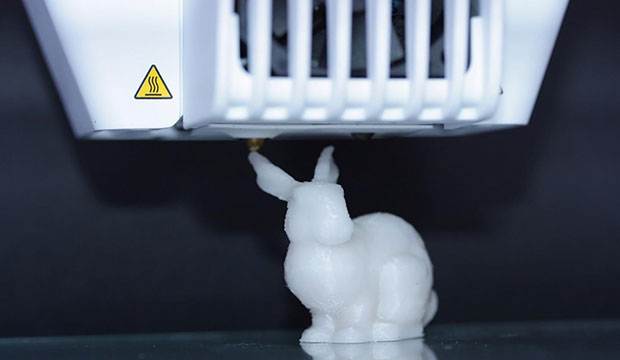Researchers at the Swedish university ETH Zurichat have unveiled a method for mixing genetically encoded digital data into common manufacturing materials. They carried out the project in collaboration with an Israeli scientist.
The team succeeded in embedding artificial DNA in a small plastic 3D-printed plastic bunny, which would allow self-replication, according to a report published Monday in Nature Biotechnology, “A DNA-of-things storage architecture to create materials with embedded memory.”
The name of the new process — “DNA of Things,” or “DoT” — alludes to the Internet of Things, or IoT, a technology that connects so-called smart appliances and the information they contain via the Internet.
“There are several unique possibilities with the research ETH Zurich has done,” said Braden Perry, partner at Kennyhertz Perry.
“This could be a transformative technology,” he told TechNewsWorld.
Similar to Biological DNA
Like biological DNA, this new storage medium holds information across generations. Essential information can be stored in everyday objects for future reference or replication.
With the ability to embed information in any object, including plasma or liquid objects, the possibilities are endless. The technology could allow any object to have its own “DNA” with the ability to replicate that object at any time, Perry explained.
“Paint colors could be recreated without unreliable color matching. Organic compounds could be tagged to be able to be identically reproduced,” he suggested.
For example, soil with a certain chemical that has produced ideal crops could be reproduced easily.
Medical compounds would be much easier to replicate, Perry said. A key use of this new storage capability could be to enable marking medications. Medical personnel could read medication logs and test results stored directly in an easily transportable object.
Construction materials could have information about their quality and replication details stored directly in the materials.
Another application of this DoT technology could be a way to conceal information in everyday objects, a process referred to as “steganography.”
How It Works
DNA storage makes it possible to place substantial information into a structure to produce materials with unchangeable memory. In this new storage architecture, DNA molecules record the data. The molecules are then encapsulated in nanometer silica beads and are fused into various materials to print or cast objects in any shape.
The scientists first applied the process to make a 3D-printed bunny that contained a 45KB digital DNA blueprint for its synthesis. The scientists synthesized five generations of the bunny. Each contained the memory of the previous generation without additional DNA synthesis or degradation of information.
To test the scalability of DoT, the researchers stored a 1.4MB video in the DNA storage format in plexiglass spectacle lenses. They then retrieved it by excising a tiny piece of the plexiglass and sequencing the embedded DNA.
The new DoT memory storage process could be applied to store electronic health records in medical implants to hide data in everyday objects (steganography) and to manufacture objects containing their own blueprint. It also could facilitate the development of self-replicating machines, according to the research team.
Developmental Path
Over the past few years, researchers bridged several milestones that made the new DoT storage process possible. One success involved marking products with a DNA “barcode” embedded in very tiny glass beads. That process was developed by Robert Grass, professor at the Department of Chemistry and Applied Life Sciences at EHT Zurichat.
The nanobeads can be used as tracers for geological tests or as markers for high-quality foodstuffs. The barcoding verifies the items are not counterfeits. The barcode’s structure is relatively short. It contains a 100-bit code of 0s or 1s.
A second success involved the ability to store enormous data volumes in DNA. Grass’ colleague Yaniv Erlich, an Israeli computer scientist, developed a method that makes it possible to store 215,000 terabytes of data in a single gram of DNA. Grass and Erlich combined those two inventions to create a new form of data storage.
Security Concerns
There could be dangers associated with DNA-based storage, cautioned Paul Katzoff, CEO of WhiteCanyon Software. For instance, how do you know the data has been erased?
Might this new process run afoul of tightly controlled security regulations imposed by the GDPR and other domestic and foreign governments? he wondered.
You can not be data privacy-compliant unless you have proof that you can eliminate the data from the DNA-based storage, Katzoff maintained.
“This method of storage has a fantastical quality to it, but it creates major privacy compliance concerns,” he told TechNewsWorld.
Securing this information will be a challenge, Perry said.
“Unlike traditional storage means, the mechanism is done through molecules that may be accessible to anyone,” he noted, “and encryption may be a challenge due to the nature of the molecular information storage.”






















































